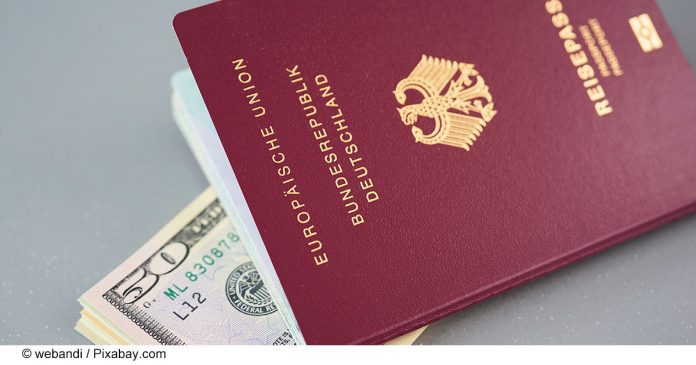We provide information about the advantages and disadvantages of the various options. You should be careful with offers to convert the foreign currency directly into euros.
Whether Spain, Italy or a travel destination overseas – when preparing for a holiday abroad, it is also important to consider the question of whether cash alone is sufficient, which cards are suitable and what traveler's checks are worth. Caution is advised if merchants or ATMs outside the euro zone offer to convert the local currency directly into euros.
The basic rule is: never rely on just one payment method! For a weekend vacation in Austria, it may still be enough to rely entirely on cash. Even if you're on holiday for a week, you should be on the safe side and be able to choose between several options on site. We provide information about the advantages and disadvantages of the various options.
cash
Cash is easy and is accepted almost everywhere. So it's logical that cash is part of the basic equipment of every wallet, even abroad. How much cash you should take with you depends on various factors:
- How long is your stay?
- What is the risk that you will lose the money or have it stolen?
- How easy is it for you to use other payment methods such as debit or credit cards?
Basically, you should make sure that you never use up your entire cash supply. You should also never carry all of your cash on your person. Divide your supply and leave some in a safe place, such as your hotel safe.
If you are traveling to a country outside the Eurozone, you should exchange at least a small part of your money into foreign currency at your home location. This means you can easily pay for the taxi ride to the hotel, a tip or the first supply of food and drinks.
But check beforehand whether you are allowed to import the foreign currency into the holiday country. Some countries limit imports of their own currency to relatively small amounts. You can find information on this, for example, on the Federal Foreign Office homepage. It is also not always possible to export the local currency in unlimited amounts.
Bank customer cards (formerly EC cards)
Many consumers know the classic customer card from their own bank as an EC card. Today we correctly speak of the debit card. You can use it to withdraw money and make card payments, among other things.
Giro card
The debit card is generally also suitable for use abroad (withdrawing money and paying). The two best-known systems for this are Maestro (from Mastercard) and V Pay (from Visa). Both providers are better known to consumers for their credit cards. The companies also sell the debit cards described here. There are also other providers, such as EUFISERV, offered by the European savings banks. Consumers can tell which system their card supports by looking at the logos on the card.
V Pay cards
However, cards with the V Pay symbol could cause annoyance in other European countries. With these cards, only the chip is read for withdrawing money and making payments. Older machines or cash register systems that can only read the magnetic strip on the card then refuse to work. VISA does not expect any difficulties with acceptance. But if you want to be on the safe side, it is better to ask your financial institution whether you can easily get money at your holiday destination.
According to current knowledge, there may be acceptance problems outside Europe for cards with the V Pay logo. However, this risk seems to be getting smaller and smaller. The card has already been accepted in some non-European countries, for example in parts of Türkiye or Israel. Visa now states on its own homepage that the V Pay cards are accepted worldwide wherever chip and PIN payments are available. To be on the safe side, you should check with your own bank about acceptance.
Maestro card
The Maestro card, on the other hand, is different. It also allows for orders using the magnetic strip. This can basically be used worldwide. However, it is precisely this advantage that can also pose a risk: criminals can read the data on the magnetic strip using skimming and then create a copy of the card.
Attention: The Maestro function will be gradually discontinued. We have summarized information about the shutdown for you in the text “No more Maestro function for checking cards”.
Before you travel, ask your bank how much it costs to use your card abroad. Please note: the institutes often only provide information about their own fees. In addition, local banks or retailers may also charge a fee. For example, for using the on-site ATM. If you pay in a foreign currency, an unfavorable exchange rate can also cause unnecessary costs.
Card payment abroad
This is different from card payments outside the EU Payment in Europe in euros currently for free. The background is the EU price regulation, which regulates that cross-border payments in the EU must not be more expensive than domestically. Included There is no charge for card payments within Germany is charged, this is also not permitted for euro payments abroad.
Cash withdrawal abroad
When withdrawing money, both in European and non-European countries Fees to.
Conclusion bank customer cards
Regardless of which card you take with you on vacation, there is at least a chance that you will be stuck with the costs if fraudsters get their hands on your card and then spend your money. If possible, you should never give the card away and have it blocked immediately if you lose it.
If you only have a bank card without a Maestro, EUFISERV or V Pay mark, you should not use it abroad – these cards are generally only intended for use in Germany.
Savings cards
Another type of bank customer card follows in the footsteps of the old postal savings book, which could be used to withdraw money in many countries. This hasn't been possible for more than a decade now. However, some large banks now offer savings cards that also allow withdrawals abroad. The exact conditions and the number of acceptance points differ from bank to bank. However, with all of them you can only use previously built up credit. The amount of withdrawals per month is usually limited. This makes it easier to keep an overview, but limits flexibility.
Pay attention to the prices for using the cards, including at ATMs! Fees should be displayed there before you withdraw funds. Prices may have changed in recent years – including with your agreement to new General Terms and Conditions (GTC).
If you want to rely on such a card on vacation, you should clarify in advance whether the card is accepted at your destination – and what costs may arise. The following also applies here: ask your bank or savings bank. Note: However, you cannot pay with such a savings card.
Credit cards
Credit cards can be very practical abroad: you can use them to withdraw money from ATMs and also pay in numerous shops and restaurants. The currency of the country you are in usually doesn't play a role.
However, credit cards pose the same security problems as bank cards. As with these, it can sometimes be difficult to keep track of all account transactions – especially during longer stays abroad. Here you will find the most important differences between credit cards and debit cards.
In any case, you should find out in advance what fees you will incur when withdrawing and paying money. Basically, you should differentiate between three cost factors. The fees charged by your own bank or credit card company. The exchange rate for foreign currencies. As well as fees from the bank or local dealer. For example, local ATM operators charge a fee for using their machine. Merchants may also charge a fee for paying by card.
The advertising slogan of some banks that you can use the card to “withdraw and pay money worldwide for free” often only refers to your own fees. If in doubt, check with your bank.
Be careful, cost trap! Direct conversion into euros
Caution is advised if the ATM abroad offers to convert the local currency directly into euros (“Immediate conversion”, “Payout with conversion”, “Dynamic Currency Conversion” or “DCC”). The machine often attracts customers with promises such as “guaranteed exchange rate” or “no surcharge”. In fact, it is usually expensive for the customer because the ATM operators use a poor exchange rate or charge surcharges. As a rule, it is cheaper to refuse the conversion. The credit card company or local bank will then take care of this – at better conditions.
The same problem exists with card payments at the checkout, for example at the gas station or in the restaurant. Customers should not accept the offer to pay directly in euros. As a rule, the exchange rates of the banks at home and the credit card companies are cheaper than those of the retailers. Before entering the PIN or signing the receipt, make sure that the requested amount is in the local currency. Otherwise, the unfavorable immediate conversion may simply be foisted on you.
Traveler's checks
Traveler's checks used to be an additional alternative when choosing payment methods abroad. These were issued, for example, by companies such as American Express or Thomas Cook. Their importance has declined primarily due to the widespread use of credit cards, so that in practice they play no or only a marginal role and are de facto no longer issued, at least in Germany. If you still have old traveler's checks, you should inquire about their acceptance at your holiday destination before you travel.
The advantage of traveler's checks: They were a fairly secure means of payment. Anyone who wanted to use traveler's checks had to sign each check when they received the checks. If he wanted to cash a check, he had to sign again and present an ID card or passport. The issuing companies also promised to replace lost traveler's checks within a few days. Fees were then due for the reissue, but there was insurance cover. Traveler's checks were therefore well suited for traveling to unsafe countries.
Nevertheless, traveler's checks also had some disadvantages, such as their relatively high cost. There was usually a minimum fee of six euros, which had to be paid when purchasing the traveler's checks. Additional fees were incurred when redeeming. Traveler's checks were available in many major currencies such as euros, US dollars, British pounds, Swiss francs and Japanese yen.
In case of emergency: transfer money abroad
Just in case, before you go on a long holiday abroad, you should also clarify how relatives or acquaintances can send you money abroad. The fastest way to do this are so-called flash transfers, which are offered by money transfer services such as Western Union or Moneygram. To send or receive money using these services, you don't need a bank account, just a valid ID and various personal details of the sender or recipient. The money can usually be collected from payment service providers in the recipient country just a few minutes after the transfer.
Con: This service can be terribly expensive. So you should avoid getting into such an awkward position that you have to have money sent to you this way. The clever combination of various payment methods mentioned above protects you from this.
The website www.geldtransfair.de, which is operated on behalf of the Federal Ministry for Economic Cooperation and Development, can help you compare the conditions of different providers. This website will no longer be updated from June 30, 2022, but will at least show different providers.


